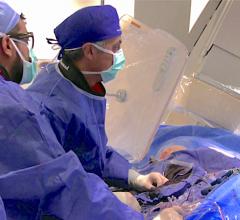
There is skepticism among cardiologists whether flat panel detectors can help lower the X-ray dose more than using traditional image intensifiers in the cath lab. There was a story concerning this in the last issue of DAIC which said flat panel detectors are replacing image intensifiers partly because they help lower the X-ray exposure to patients.
This prompted a letter to the editor from John K. Grady, PE, principal owner of Grady Research Inc., which specializes in the design, manufacture, sale and service of interventional imaging systems. He previously owned the XRE Corp., which designed and built cardiac catheterization imaging equipment for most of the major suppliers on a private-label basis. He’s the sort of guy who might know a little more about these systems than me or the average Joe cardiologist.
He wrote, “For what it is worth, testing a flat panel on digital subtraction angiography (DSA) as the article has reported on, has no relevance at all to flat panel dose on fluoro, which is the major source of dose in interventional procedures. DSA is inherently a high dose procedure... Flat panels unequivocally have about two-times higher dose then II tubes (image intensifiers) on fluoro. This is due to known inherent high electrical noise. This has been proven in the field by comparison studies in Germany and now Australia... and is well known from the physics of the devices, published and discussed at the International Society for Optical Engineering (SPIE). Same case type, same time for procedure – two times more. That is what needs to be reported, not anecdotal stories about what an M.D. using any particular brand thinks about it.”
Grady went on to say this is an example of misperceptions propagated by salesmen for the device manufacturers. “Such scientific studies overrule opinions of individual M.D.’s who mostly listen to salesmen, who in turn reassure them about low dose,” he argued.
In his experience, Grady said the flat panels he has measured are set up for 4-5 uR (micro Roentgens) per frame on fluoro, whereas II tubes were routinely set up at 2-2.5 uR per frame. He said typically the amount entering the image forming detector and leaving the patient is only about 1 percent of the radiation entering the patient (99 percent is absorbed), but that latter observation varies widely with patient size. Higher X-ray doses are used in radiography, DSA, angiography and mammography to cut noise, 10 to 100 times more per frame as fluoro, but for a shorter duration, he said.
“That is what is needed to be published - the specific input uR per frame on fluoro, which correlates directly to patient dose, and has no opinion aspect to it,” Grady said.
Since the story Mr. Grady refers to included GE products, I asked GE’s Interventional Clinical Development Manager Barry Belanger his opinion. He wrote, “John Grady is correct in saying there are published reports of higher fluoro doses with flat panel detectors than with II’s. However, in the mid 1980s, GE recognized that major efforts would be required to make their flat panel detectors at least as dose efficient for fluoro operation as conventional II-based systems. That’s why GE made a huge effort to minimize noise sources on its proprietary panel designs, and opted for a more challenging, proprietary integrated readout electronics design incorporating one analog to digital converter for each readout column of the panel to minimize electronic noise. The result is that GE’s flat panel detectors have the highest fluoro DQE values in the industry.”


 January 31, 2024
January 31, 2024 






